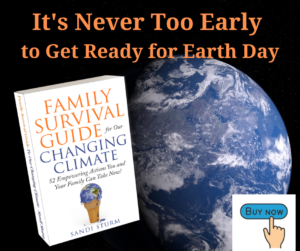car·bon foot·print /ˌkärbən ˈfo͝otprint/
A carbon footprint is historically defined as the total emissions caused by an individual, event, organization, or product, expressed as carbon dioxide equivalent. Wikipedia
Every purchase we make and every activity we do for our family has a carbon footprint.
The book on your shelf was once a tree which was a seed deposited in the dirt as much as 50 – 100 years ago. While it grew it relied on the atmosphere to create the ideal temperatures through all seasons. It relied on the water cycle to provide precipitation at correct amounts – too little and it would be distressed by drought and be subjected to disease and pests. Too much and it would be threatened by floods and landslides. Conditions were “just right” for it to mature and be harvested.
While the tree is in the ground, it is removing CO2 and other harmful gases, such as sulfur dioxide and carbon monoxide, from the atmosphere and releases oxygen. In fact, one large tree can supply a day’s supply of oxygen for four people.
Carbon is also stored in the soils. The amount stored is a component of soil organic matter, which is the plant and animal materials that are in the soil in various stages of decay. The world’s soils holds approximately twice the amount of carbon than is found above ground in the atmosphere and plants.
As shown in the illustration, CO2 is used by plants during photosynthesis and the plant releases oxygen that is used by animals and humans. In water, CO2 is absorbed from the atmosphere and also from fish, and converted into oxygen by aquatic plants.
Harvesting the tree to make those book pages stops this process and also releases carbon into the atmosphere.
Fossil fuels are used in every step of the process of making a book. Someone drove to the forest and determined what trees would be harvested. Someone drove their vehicle to the harvest sites to jump into heavy equipment, powered by diesel, to cut down the trees and put them onto large log trucks which drive to the saw mills or to the coast to be shipped to other regions for processing. All of the vehicles are using fossil fuels and emitting CO2 into our thin layer of atmosphere and the air we all need to live here.
Once the trees are at the processing mill, they are chipped into small pieces. These chips of wood are then sent to a paper mill, which can be anywhere in the world, where they are turned into pulp. This pulp can then be turned into paper. This requires large amounts of electricity, and water, to run equipment and heat or cool the facility.
According to the U.S. Energy Information Administration, in 2018, about 63% of our electricity was generated by fossil fuels (coal, natural gas, petroleum, and other gases).
Paper is manufactured into large round bales and shipped to different locations that turn it into different end products – books, newspapers, journals, wrapping paper, cash register receipts, boxes, and many more. Each application requires more energy.
Now our book is packaged and put into cardboard boxes (it’s own carbon journey) and shipped in gas powered vehicles to distribution centers. These are then repackaged in other cardboard boxes and shipped to either a retail store, or to yet another distribution center, where it will be shipped again or drop shipped directly to the consumer.
In our scenario, we are heading to the bookstore to buy the book. Unless we have an electric vehicle that is charged by a renewable source, we are again using fossil fuels and emitting more CO2 into the atmosphere during our drive there and back home.
The total amount of CO2 this book has put into the atmosphere is difficult to know, but we do know that the pulp and paper sector had direct emissions of about 35.8 metric tons of CO2 in 2017.
Look around you. Every single item in the room you are sitting in has a carbon footprint. It had a long journey through resource exploration, extraction, manufacturing and transportation, which all use fossil fuels and contribute to greenhouse gasses being emitted into our atmosphere. The longer the journey, the more CO2 and other greenhouse gases were created.
While China is the largest producer of CO2, it is estimated that one-third of China’s emissions are stimulated by the United State’s demand for exported products. Data collected by the International Energy Agency in 2015 shows the U.S. is the largest carbon dioxide emissions from fuel combustion at 15.53 metric tons per year per person, and China with 6.59 metric tons, followed by India at 1.58 metric tons. This demonstrates how our personal purchasing decisions affect the rest of the world.
Think before you make a purchase or plan your day. The little things do matter.










